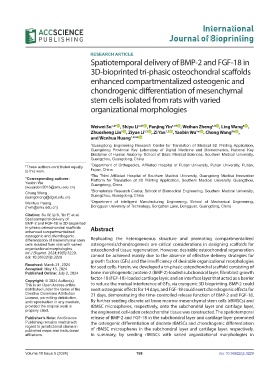Page 206 - IJB-10-5
P. 206
International
Journal of Bioprinting
RESEARCH ARTICLE
Spatiotemporal delivery of BMP-2 and FGF-18 in
3D-bioprinted tri-phasic osteochondral scaffolds
enhanced compartmentalized osteogenic and
chondrogenic differentiation of mesenchymal
stem cells isolated from rats with varied
organizational morphologies
Weiwei Su 1,2† id , Shiyu Li 1,3† id , Panjing Yin 1,3† id , Weihan Zheng 1,3 id , Ling Wang 4 id ,
Zhuosheng Lin 1 id , Ziyue Li 1,3 id , Zi Yan 1,3 id , Yaobin Wu * , Chong Wang * ,
1 id
5 id
and Wenhua Huang 1,2,3 id
*
1 Guangdong Engineering Research Center for Translation of Medical 3D Printing Application,
Guangdong Provincial Key Laboratory of Digital Medicine and Biomechanics, National Key
Discipline of Human Anatomy, School of Basic Medical Sciences, Southern Medical University,
Guangzhou, Guangdong, China
† These authors contributed equally 2 Department of Orthopedics, Affiliated Hospital of Putian University, Putian University, Putian,
to this work. Fujian, China
3 The Third Affiliated Hospital of Southern Medical University, Guangdong Medical Innovation
*Corresponding authors:
Yaobin Wu Platform for Translation of 3D Printing Application, Southern Medical University, Guangzhou,
(wuyaobin2018@smu.edu.cn) Guangdong, China
4 Biomaterials Research Center, School of Biomedical Engineering, Southern Medical University,
Chong Wang
(wangchong@dgut.edu.cn) Guangzhou, Guangdong, China
Wenhua Huang 5 Department of Intelligent Manufacturing Engineering, School of Mechanical Engineering,
(hwh@smu.edu.cn) Dongguan University of Technology, Songshan Lake, Dongguan, Guangdong, China
Citation: Su W, Li S, Yin P, et al.
Spatiotemporal delivery of
BMP-2 and FGF-18 in 3D-bioprinted
tri-phasic osteochondral scaffolds Abstract
enhanced compartmentalized
osteogenic and chondrogenic
differentiation of mesenchymal stem Replicating the heterogeneous structure and promoting compartmentalized
cells isolated from rats with varied osteogenesis/chondrogenesis are critical considerations in designing scaffolds for
organizational morphologies. osteochondral tissue regeneration. However, desirable osteochondral regeneration
Int J Bioprint. 2024;10(5):3229.
doi: 10.36922/ijb.3229 cannot be achieved mainly due to the absence of effective delivery strategies for
growth factors (GFs) and the insufficiency of desirable organizational morphologies
Received: March 21, 2024 for seed cells. Herein, we developed a tri-phasic osteochondral scaffold consisting of
Accepted: May 13, 2024
Published Online: July 2, 2024 bone morphogenetic protein-2 (BMP-2)-loaded subchondral layer, fibroblast growth
factor-18 (FGF-18)-loaded cartilage layer, and an interface layer that acted as a barrier
Copyright: © 2024 Author(s).
This is an Open Access article to reduce the mutual interference of GFs, via cryogenic 3D bioprinting. BMP-2 could
distributed under the terms of the exert osteogenic effects for 14 days, and FGF-18 could exert chondrogenic effects for
Creative Commons Attribution 21 days, demonstrating the time-controlled release function of BMP-2 and FGF-18.
License, permitting distribution,
and reproduction in any medium, By further seeding discrete rat bone marrow mesenchymal stem cells (rBMSCs) and
provided the original work is rBMSC microspheres, respectively, onto the subchondral layer and cartilage layer,
properly cited. the engineered cell-laden osteochondral tissue was constructed. The spatiotemporal
Publisher’s Note: AccScience release of BMP-2 and FGF-18 in the subchondral layer and cartilage layer promoted
Publishing remains neutral with the osteogenic differentiation of discrete rBMSCs and chondrogenic differentiation
regard to jurisdictional claims in
published maps and institutional of rBMSC microspheres in the subchondral layer and cartilage layer, respectively.
affiliations. In summary, by seeding rBMSCs with varied organizational morphologies in
Volume 10 Issue 5 (2024) 198 doi: 10.36922/ijb.3229

